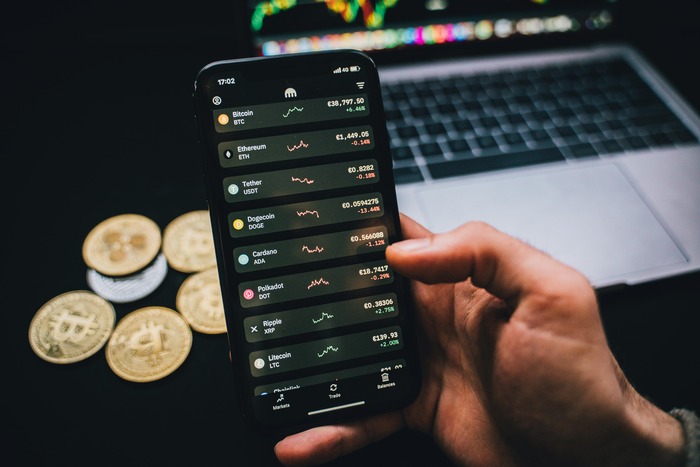Crypto Trading vs. Holding: Which Strategy Is Right for You?
- 20 Oct 2024

Cryptocurrency investors often face a fundamental question: Should I trade my crypto actively, or should I hold it long-term? Both strategies have their advantages and disadvantages, and the decision depends on your financial goals, risk tolerance, and time commitment. This article breaks down the key differences between crypto trading and holding, helping you decide which strategy is right for you.
What Is Crypto Trading?
Crypto trading involves buying and selling cryptocurrencies frequently to profit from short-term price movements. Traders aim to take advantage of volatility in the crypto market by executing trades based on technical analysis, market trends, and news events. Some traders engage in day trading, making multiple trades in a single day, while others may employ swing trading, holding assets for several days or weeks to capture price fluctuations.
Types of Crypto Trading
-
Day Trading: Involves making multiple trades within a single day, capitalizing on small price changes. Day traders often hold positions for minutes or hours, closing all trades before the end of the day to avoid overnight risk.
-
Swing Trading: Swing traders hold positions for several days or even weeks, attempting to profit from medium-term price trends. Unlike day traders, they are not concerned with minute-to-minute fluctuations.
-
Scalping: Scalpers make numerous small trades to profit from tiny price movements. This strategy requires a lot of time, attention, and a deep understanding of market dynamics.
-
Position Trading: Similar to holding, position traders aim to buy during dips and sell during peaks, but they are willing to hold their assets for months or longer to maximize returns.

What Is Crypto Holding?
Crypto holding, often referred to as HODLing, is the long-term investment strategy where investors buy cryptocurrency and hold it for an extended period, regardless of market fluctuations. HODLers believe in the long-term potential of cryptocurrencies like Bitcoin or Ethereum and expect prices to increase over time. The term “HODL” originated from a misspelled word in a Bitcoin forum in 2013, standing for “Hold On for Dear Life,” which has since become a mantra for many in the crypto space. For more crypto-related terms, check out our post Common Crypto Terms Explained.
Benefits of Holding
-
Lower Stress: Holding requires much less daily attention than trading. You aren’t worried about short-term market fluctuations, making it ideal for those who don’t want to monitor the market constantly.
-
Potential for Long-Term Gains: Historically, cryptocurrencies like Bitcoin have shown significant appreciation over time. Holding allows investors to capitalize on the long-term upward trends of these assets.
-
Lower Tax Implications: Depending on your country, long-term capital gains taxes may be lower than short-term trading taxes. Holding for over a year can offer tax advantages for some investors.
Comparing Trading and Holding: Risk and Reward
1. Volatility and Risk
- Trading: Trading exposes you to short-term market volatility. While this creates opportunities for quick gains, it also increases the potential for significant losses. Successful traders rely on disciplined strategies, such as setting stop-loss orders, to manage risks effectively.
- Holding: HODLers are more insulated from short-term volatility, focusing instead on the long-term growth potential of their investments. While they may endure bear markets, the expectation is that prices will eventually recover.
2. Time Commitment
-
Trading: Crypto trading demands constant attention. Traders must monitor market trends, analyze price charts, and stay updated on news. Day traders and scalpers, in particular, need to dedicate significant time to manage their positions effectively.
-
Holding: Holding is a hands-off strategy, ideal for those with limited time to monitor the market. Once you buy an asset, the primary task is to wait until your investment reaches your desired value, requiring minimal day-to-day effort.
3. Financial Returns
- Trading: While trading offers the potential for rapid returns, it requires a high level of skill, knowledge, and discipline to be consistently profitable. Many novice traders face losses before developing the expertise needed for success.
- Holding: Holding may not provide quick profits, but it has historically yielded substantial long-term returns, especially for early adopters of assets like Bitcoin and Ethereum.
4. Emotional Control
-
Trading: The fast pace of trading can trigger emotional responses like panic selling or fear of missing out (FOMO). Successful traders learn to manage these emotions and adhere to their strategies.
-
Holding: HODLing requires patience and resilience. Bear markets can test an investor’s resolve, but long-term holders rely on their belief in the future potential of their investments.
Who Should Consider Crypto Trading?
Crypto trading is suited for individuals who:
- Have a deep understanding of technical analysis, market trends, and trading tools.
- Are willing to dedicate significant time to research and active market participation.
- Can manage high levels of risk and maintain emotional discipline during market fluctuations.
Who Should Consider Holding?
Crypto holding is ideal for those who:
- Believe in the long-term value of cryptocurrencies and their potential to revolutionize industries.
- Prefer a more passive investment approach, requiring less time and effort.
- Are patient and willing to endure short-term losses for the possibility of long-term gains.
A Hybrid Strategy: Combining Trading and Holding
Many investors combine both strategies to balance risks and rewards. For example:
- Core Holding with Active Trading: Investors hold a core portfolio of long-term assets (like Bitcoin or Ethereum) while actively trading smaller amounts to capitalize on market fluctuations.
- Dollar-Cost Averaging (DCA): A common holding strategy where investors buy a fixed amount of cryptocurrency at regular intervals, reducing the risk of market timing and benefiting from lower average purchase prices over time.

Risk Management Strategies
Effective risk management is vital for both traders and holders to safeguard investments and navigate the volatile cryptocurrency market. Below is a summary of key strategies tailored to each approach.
| Strategy | Traders | Holders |
|---|---|---|
| Stop-Loss Orders | Automatically sell a position when the price hits a predefined level, limiting potential losses. Example: Selling Bitcoin at $28,500 if purchased at $30,000. | Not typically applicable to holders as they aim for long-term growth rather than short-term trades. |
| Position Sizing | Allocate only 1–2% of your portfolio per trade to minimize the impact of a single loss. | Diversify across multiple assets (e.g., Bitcoin, Ethereum, and altcoins) to reduce reliance on a single cryptocurrency. |
| Avoid Over-Leveraging | Refrain from using excessive borrowed funds to trade, as it amplifies both gains and losses, increasing the risk of liquidation. | Not applicable, as leveraging is generally not a practice for long-term holders. |
| Diversification | Diversify trading pairs to spread risk but maintain focus on manageable positions. | Invest in cryptocurrencies with strong fundamentals and potential for long-term growth to safeguard your portfolio. |
| Research and Selection | Analyze charts, trends, and short-term events to identify high-potential trades. | Focus on projects with active development teams, tangible use cases, and proven adoption to avoid speculative investments. |
| Mitigating Market Risks | Use stop-losses or reduce trading activity during prolonged market downturns. | Employ dollar-cost averaging (DCA) during bear markets to accumulate assets at lower prices, reducing the risk of timing the market incorrectly. |
Key Takeaways:
- Traders: To thrive in the volatile crypto market, traders must implement strict risk controls, such as stop-loss orders, position sizing, and avoiding leverage misuse.
- Holders: Long-term holders benefit from diversification and focusing on fundamentally strong projects. During downturns, employing dollar-cost averaging can lower the average purchase price and maximize potential gains over time.
These strategies ensure that regardless of your approach, you're prepared to mitigate risks and maximize returns effectively.
Psychological Aspects of Trading and Holding
Investing in cryptocurrency is as much about mindset as it is about strategy. Whether you’re actively trading or holding for the long term, managing emotions and staying disciplined are crucial for success.
Traders: Navigating Volatility
Traders face high-pressure environments where emotional discipline is key. The crypto market’s volatility often triggers reactions like FOMO (fear of missing out) or panic selling during downturns. Experienced traders stick to pre-defined strategies, resisting the urge to make impulsive decisions.
Overtrading is another common pitfall, driven by the constant desire to capitalize on small price movements. This approach can lead to poor judgment, excessive fees, and burnout. Instead, focus on high-confidence trades backed by thorough analysis. Beginners can mitigate risks by starting with smaller positions, which helps build confidence and resilience without exposing significant capital.
Holders: Staying Calm Through Downturns
Long-term holders face a different psychological challenge: weathering extended periods of uncertainty. Market downturns often bring about FUD (fear, uncertainty, and doubt), making it tempting to sell during dips. However, successful holders focus on the broader potential of their investments, trusting in their long-term thesis.
Patience is a defining trait of effective holders. Early adopters of Bitcoin or Ethereum reaped exponential returns by enduring market cycles and holding through both bull and bear markets. Believing in the underlying value of your investments can help you stay grounded during volatile periods.

Real-Life Examples or Case Studies
Real-life examples provide valuable insights into the successes and pitfalls of trading and holding strategies, demonstrating the importance of informed decision-making in cryptocurrency investing.
Success Stories
-
Michael Saylor and Bitcoin:
Michael Saylor, co-founder of MicroStrategy, became a prominent figure in crypto by holding Bitcoin. His company has accumulated over 331,000 BTC, viewing it as a hedge against inflation. Saylor’s long-term vision reflects the power of holding in building wealth. -
Early Bitcoin Adopters:
Many early Bitcoin investors who held their positions through years of volatility, like the 2018 bear market, experienced massive returns when Bitcoin surpassed $60,000 in 2021. Their patience exemplifies the rewards of long-term investing. -
CZ and Binance's Strategic Moves:
Binance CEO Changpeng Zhao (CZ) strategically held Binance Coin (BNB) through its development and market cycles. This decision solidified BNB's status as a top-tier cryptocurrency, helping Binance expand its ecosystem while generating significant returns for early adopters. -
Ethereum Stakers During the Merge:
Ethereum investors who staked ETH to secure the network during the Ethereum Merge (transition to proof-of-stake in 2022) not only supported the network but also earned staking rewards. Many of these stakers saw their investments grow over time.
Lessons from Mistakes
-
Overleveraged Traders in the 2021 Crash:
During the May 2021 market crash, over $10 billion worth of leveraged positions were liquidated in 24 hours. This highlights the risks of over-leveraging in a highly volatile market, where small price movements can result in significant losses. -
HODLers of Speculative Assets:
Investors who held onto speculative altcoins during market downturns often suffered significant losses, as some projects lost over 90% of their value and never recovered. Projects like Bitconnect serve as cautionary tales, demonstrating the dangers of investing in assets with weak fundamentals. -
LUNA and UST Collapse (2022):
The collapse of the Terra ecosystem wiped out billions of dollars in value. Many HODLers who believed in the long-term viability of LUNA and UST suffered devastating losses when the algorithmic stablecoin de-pegged. This emphasizes the importance of diversification and avoiding overexposure to a single project.
By examining these examples, both traders and holders can gain practical insights into effective risk management, the importance of diversification, and the potential rewards of patience and strategy in the crypto space.
Impact of Market Cycles
The profitability of trading and holding strategies depends significantly on market conditions.
The Role of Market Cycles: Bull and Bear Markets
Market cycles play a significant role in shaping the strategies of both traders and holders. Understanding how to adapt during bull and bear markets can greatly influence your success in the crypto space.
Bull Markets: Capitalizing on Growth
During bull markets, asset prices often experience rapid and sustained growth. This environment is ripe for both traders and holders, albeit in different ways.
Traders benefit from high volatility and frequent price swings, creating abundant opportunities to profit from short-term movements. Day and swing trading strategies thrive in these conditions, with skilled traders maximizing gains by timing market trends effectively.
For holders, bull markets reward patience and long-term vision. Assets often see exponential growth, and those who resist the urge to sell during the early stages of a rally can reap significant rewards. By sticking to their investment thesis, holders avoid the pitfalls of premature profit-taking.
Bear Markets: Navigating Downturns
Bear markets present a starkly different challenge, as prices decline and bullish trends become scarce. Traders face a tougher environment but can still find opportunities through strategies like shorting or trading stablecoins to secure limited profits. However, the need for caution and precise execution is paramount, as the risks increase during prolonged downturns.
For holders, bear markets test emotional resilience and conviction. Watching portfolios shrink can be discouraging, but history has shown that many major cryptocurrencies recover and reach new highs in subsequent cycles. Long-term holders who maintain their focus on the big picture often emerge stronger when the market rebounds.

The Role of Stablecoins
Stablecoins like USDT and USDC serve as essential tools for both traders and holders, offering stability in the highly volatile cryptocurrency market. Their ability to maintain a consistent value makes them a cornerstone of various strategies.
For Traders: Stability Meets Flexibility
Traders rely on stablecoins to manage volatility and maintain liquidity. When market conditions become uncertain, stablecoins allow traders to quickly exit volatile positions, locking in profits or limiting losses without leaving the crypto ecosystem.
In addition, stablecoins play a significant role in decentralized finance (DeFi). Many traders use them in decentralized exchanges (DEXs) and liquidity pools, earning passive income through staking or yield farming while preserving the stability of their assets.
For Holders: Preserving Value
For long-term investors, stablecoins provide a way to protect portfolio value during market downturns. By converting volatile assets into stablecoins, holders can secure gains and reduce exposure to sudden price drops. This strategy is particularly useful in bear markets, where it allows investors to wait for favorable market conditions without exiting the crypto space entirely.
Stablecoins also contribute to diversification by reducing overall portfolio volatility. Holding a portion of assets in stablecoins offers a financial buffer during periods of uncertainty, making them an invaluable tool for risk management.
Stablecoins are increasingly relevant in the broader financial ecosystem, playing a vital role in the development of Central Bank Digital Currencies (CBDCs) and bridging the gap between traditional finance and the digital economy.
Conclusion: Trading or Holding—Which Is Right for You?
The decision between trading and holding depends on your financial goals, time availability, and risk tolerance. If you enjoy fast-paced markets and are willing to dedicate time to learning and executing trades, trading may suit you. Conversely, if you believe in the long-term potential of cryptocurrencies and prefer a hands-off approach, holding could be the better choice.
Ultimately, a balanced approach combining elements of both strategies might offer the best of both worlds, allowing you to manage risks while optimizing returns. Whatever path you choose, success in cryptocurrency investing requires discipline, patience, and continuous learning.






